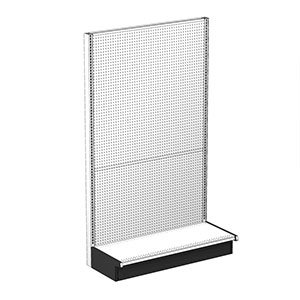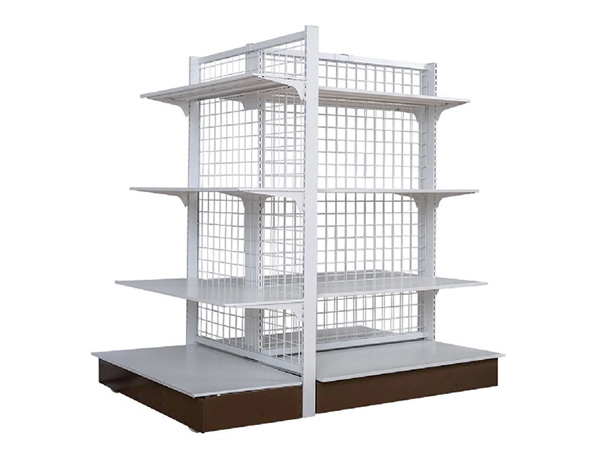12 years China Customzied Shop Fittings manufacturer

Instruction: Choosing the right height for retail shelves is an important factor in store design. The height of the shelves not only affects the aesthetics of the store, but also affects the flow of people, accessibility, safety and sales performance of the supermarket.
This article provides a comprehensive guide to choosing the best shelf height for supermarkets, improving customers’ shopping experience and increasing supermarket sales.
Choosing the right shelf height is critical and will impact the overall shopping experience. Shelves that are too high or too low can make products difficult to access, giving customers a bad shopping experience and reducing sales. Proper shelf height ensures that products are easy to access, improves product visibility, and helps create a more reasonable and efficient store layout.

1. Convenience – Consider the ergonomic characteristics of customers and design with the needs of people with disabilities
Ergonomics plays a vital role in determining shelf height. Shelves should be within the reach of ordinary customers. Studies have shown that the most comfortable reachable area is between waist and shoulder height, so that customers can more easily pick products without excessive bending or stretching.
And shelves should be convenient for disabled customers, including those using wheelchairs. Lower shelves and wider aisles ensure that all customers can shop comfortably and independently.
2. Product visibility – hot-selling products are placed at eye level
In all supermarkets, products placed at eye level are the most golden position because they are more visible and easier to pick up. Therefore, according to the world region and the height of the race, the appropriate shelf height is set to match the horizontal direction of the eyes. For example, in Asia and Southeast Asia, the shelf height is 1.5M, plus the height of the goods (0.08M), which is the best position, while in Northern Europe, the shelf height needs to be 1.7M.
3. Safety
Setting the shelves to the right height can reduce the risk of accidents. Too high, the goods will fall, which is dangerous to customers and employees. Too low, it is awkward to take and easy to sprain
,
4. Space optimization
In supermarkets, maximizing vertical space is crucial. Tall shelf units can store more products, reduce the need for frequent restocking, and make better use of available space.
Balancing shelf height and aisle width is also very important. Too wide reduces the density of goods placement, which is not conducive to sales. Too narrow, poor passability, poor shopping experience, and easy to cause congestion. So the right design can balance them.
5. Inventory management
The right shelf height helps with efficient inventory turnover. The arrangement of products should make old inventory easy to access, thereby reducing waste and ensuring freshness. Clear labeling and orderly shelves make it easier for employees to manage inventory.
Shelves with the right height speed up replenishment and reduce labor input. Employees can easily take all products, reducing the time and energy required to keep shelves full and tidy.
Shelving
Shelving is a versatile and popular choice in supermarkets. These freestanding shelves can be adjusted to a variety of heights and configurations, making them ideal for displaying a wide range of products.
End Cap Shelving
End cap shelving units are located at the end of an aisle and are the perfect location for promotional items or high-margin products. Their height should be carefully considered to maximize visibility and accessibility.
Peg Board Shelving
Peg board shelving allows for customizable display options, with adjustable hooks and shelves. This flexibility makes it easy to adapt to different product types and sizes, optimizing space and visibility.
Customizable Shelving
Adjustable shelving offers flexibility, allowing store managers to modify shelf heights based on current needs. This adaptability is essential for seasonal changes or changes in product inventory.
Modular Shelving Systems
Modular systems offer a scalable solution for evolving stores. These systems can be expanded or reconfigured as needed, ensuring the shelves always meet the store’s requirements.


Tegometall Shelving is designed by German company Tegometall. It is neat and sturdy, affordable and functional, and is most popular in Europe and the UK,

Lozier Shelving is the number one shelving system in the United States, Canada, Mexico and other Latin American countries. With the largest size and heavy-duty construction and versatile accessories, it meets all the needs of the market.

Australian Shelving features: high feet, volcanic perforated backing and black hammered finish. Dominant in Australia and New Zealand.

Australia: Australian Shelving Asian Shelving: cost-effective, sturdy welding, popular in most developing countries.


Conclusion
Choosing the right shelf height in a supermarket involves balancing accessibility, safety, and space optimization. By considering ergonomics, product visibility, and customer convenience, store managers can create a more efficient and enjoyable shopping environment. Adopting customizable and durable shelving solutions can further enhance store operations and customer satisfaction, ultimately driving sales and success.
JY has over a decade of providing one-stop metal shop fixture solution for all industry needs. With rich experience¸ we have a deep understanding about the unique challenges and requirements of our customers.